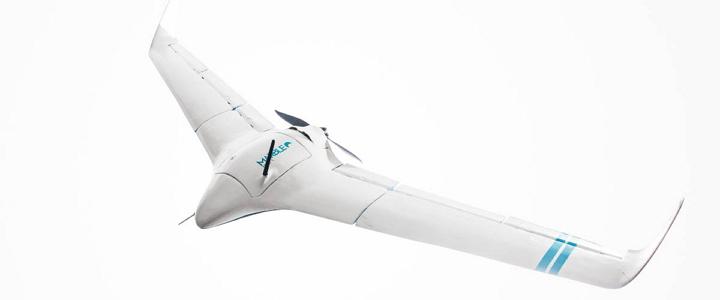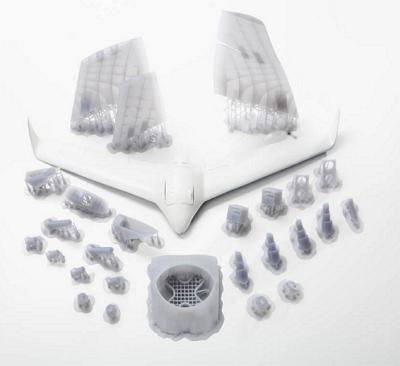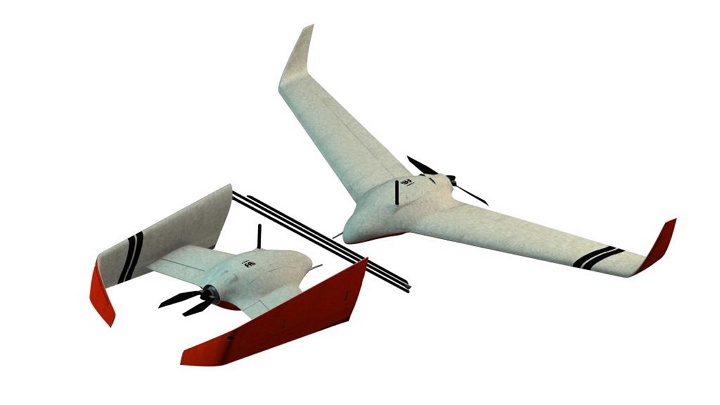 The MRB-1 drone is a removable-wing, composite body aircraft which is capable of staying aloft much longer than a quad copter drone. It’s also very easy to disassemble for transport and it was prototyped with 3D printing.
The MRB-1 drone is a removable-wing, composite body aircraft which is capable of staying aloft much longer than a quad copter drone. It’s also very easy to disassemble for transport and it was prototyped with 3D printing.
Aerospace engineer Mathieu Johnsson, the designer of the MRB-1, has an ambitious goal. He wants to develop a commercial, unmanned aerial vehicle capable of capturing 2D and 3D maps. He and four fellow engineers joined forces to put together Marble, the group’s startup company.
Johnsson currently works for Airbus where he’s responsible for ensuring the structural integrity of a wide range of components. He says his personal focus is on developing software to automate specific processes, increasing efficiency and reliability studies. He also worked on a record-breaking electric aircraft design – the Teaco project – and investigates unmanned aerial vehicle research and additive manufacturing technologies. He was a volunteer on that project which aims at creating the overall design of a single seater electric aircraft to beat the world speed record.
As for the MRB-1, Johnsson says he and his team printed a full compliment of custom parts for their drone, and those parts included an engine housing, winglets and a scaled-down version of the entire drone which helped them visualize the end product. The Marble MRB-1 also boasts custom, flush mounting screws, internally braced wingtips, and an engine mount designed to save weight and preserve the stiffness of the craft.
 Johnsson and Marble settled on a “blended wing” design for their drone to optimize aerodynamic and structural performance. The UAV makes use of composites and 3D printed parts to reduce drag and increase flight time, and they say this combination of strength and efficiency will allow for maximum flight time for its intended purpose of collecting mapping data.
Johnsson and Marble settled on a “blended wing” design for their drone to optimize aerodynamic and structural performance. The UAV makes use of composites and 3D printed parts to reduce drag and increase flight time, and they say this combination of strength and efficiency will allow for maximum flight time for its intended purpose of collecting mapping data.
Cameras mounted beneath the drone will be capable of capturing customized, high fidelity maps in the field, and Johnsson and his team used a Form 1+ printer from formlabs to build their prototypes.
“We can now produce exchangeable modules – thanks to the geometrical accuracy – without the need for molded parts,” Johnsson says. “It gives us the possibility to manufacture small batches of early-version product that we will sell to customers before committing to manufacturing methods more optimized for larger scale production. For most parts, we may not be able to manufacture them any other way, without compromising on weight or functionality.”
He adds that prototyping with 3D printing enables the Marble team to create short runs of complex fixtures and fittings which saves on the cost of creating the expensive tooling which would otherwise be necessary to build them.
“Whatever design we make, we only need a few hours to have it manufactured with the Form 1+,” Johnsson says. “This helps designers try unconventional or risky ideas, without hours of preliminary analysis.”
Subscribe to Our Email Newsletter
Stay up-to-date on all the latest news from the 3D printing industry and receive information and offers from third party vendors.
You May Also Like
Precision at the Microscale: UK Researchers Advance Medical Devices with BMF’s 3D Printing Tech
University of Nottingham researchers are using Boston Micro Fabrication‘s (BMF) 3D printing technology to develop medical devices that improve compatibility with human tissue. Funded by a UK grant, this project...
3D Printing Webinar and Event Roundup: April 21, 2024
It’s another busy week of webinars and events, starting with Hannover Messe in Germany and continuing with Metalcasting Congress, Chinaplas, TechBlick’s Innovation Festival, and more. Stratasys continues its advanced training...
3D Printing Webinar and Event Roundup: March 17, 2024
It’s another busy week of webinars and events, including SALMED 2024 and AM Forum in Berlin. Stratasys continues its in-person training and is offering two webinars, ASTM is holding a...
3D Printed Micro Antenna is 15% Smaller and 6X Lighter
Horizon Microtechnologies has achieved success in creating a high-frequency D-Band horn antenna through micro 3D printing. However, this achievement did not rely solely on 3D printing; it involved a combination...































